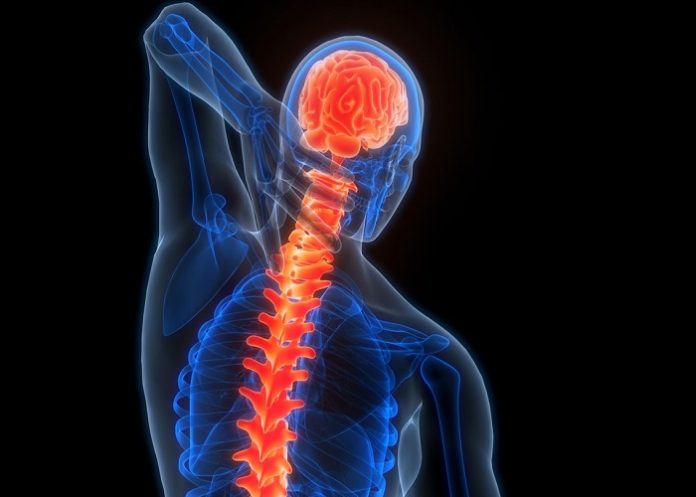Texas researchers have said that unprecedented rates of recovery were exhibited in patients with spinal cord injuries who had received a combination of stimulation of a nerve in the neck and progressive, individualised rehabilitation.
The approach, called closed-loop vagus nerve stimulation (CLV), produced meaningful improvements in arm and hand function in the clinical study, they said in their findings, published in the journal Nature.
The study, led by the Texas Biomedical Device Centre (TxBDC) at The University of Texas, positions the scientists to proceed with a pivotal trial – the final hurdle on the road to potential Food and Drug Administration (FDA) approval of vagus nerve stimulation for treatment of upper-limb impairment due to spinal cord injury.
This approach is based on more than a decade of neuroscience and bioengineering efforts by investigators at UT Dallas.
The therapy uses electrical pulses sent to the brain via a tiny device implanted in the neck and timed to occur during rehabilitative exercises. Previous work by UT Dallas researchers has demonstrated that stimulating the vagus nerve during physical therapy can rewire areas of the brain damaged by stroke and lead to improved recovery.
Dr Michael Kilgard, the Margaret Fonde Jonsson Professor of Neuroscience in the School of Behavioural and Brain Sciences and corresponding author, said treating spinal cord injury with CLV was different from conditions targeted in earlier studies.
“In stroke, people who do only therapy may get better, and adding CLV multiplies that improvement,” he said. “This study is different: therapy alone for spinal cord injury didn’t help our participants at all.”
The trial involved 19 participants with chronic, incomplete cervical spinal cord injury. Each person performed 12 weeks of therapy, playing simple video games to trigger specific upper-limb movements. The implant was activated upon successful movements, resulting in significant benefits for arm and hand strength.
“These activities allow patients to regain strength, speed, range of motion and hand function. They simplify daily living,” said Dr Robert Rennaker, Professor of Neuroscience and the Texas Instruments Distinguished Chair in Bioengineering, who designed the miniature implanted CLV device.
The study served as both a phase 1 and phase 2 clinical trial and included randomised placebo control in its first phase, in which nine of the 19 participants received sham stimulation rather than active treatment during the first 18 therapy sessions, then received CLV in the latter 18 sessions.
The participants ranged in age from 21 to 65 and were from one to 45 years’ post-injury. Neither of those factors, nor the severity of the impairment in those with any hand movement, influenced the degree of response to treatment.
“This approach produces results regardless of these factors, which often cause significant differences in success rates of other types of treatment,” said study co-author Dr Jane Wigginton, medical doctor and chief medical officer at TxBDC, co-director of UTD’s Clinical and Translational Research Centre, and medical science research director at the Centre for BrainHealth.
“It is remarkable from a medical standpoint,” said Wigginton, who planned the clinical interactions and patient protections for the trial.
TxBDC has worked to treat a wide variety of conditions using CLV across 13 years of research. As a result, the FDA has approved vagus nerve stimulation for treating impaired upper-limb movement in stroke patients.
Wigginton said the latest results are especially exciting because they help people for whom there is no existing solution.
“The people in this study have now gained the ability to do things that are meaningful for them and have an impact on their lives.”
The newest generation of the implantable CLV device, designed by Rennaker, is approximately 50 times smaller than their version from three years ago. It does not prevent patients from receiving MRIs, CT scans or ultrasounds.
A phase 3 pivotal trial will include 70 participants at multiple US institutions that specialise in spinal cord injury.
Co-author Dr Seth Hays, associate Professor of Bioengineering and Fellow, Eugene McDermott Distinguished Professor in the Erik Jonsson School of Engineering and Computer Science, has been with the CLV project dating back to the earliest studies.
“Before this study, no one with spinal cord injury had ever received CLV,” he said. “This is the first evidence that gains can be made. Now we will set about determining how we make this optimally effective.”
Hays cautioned that it was not a foregone conclusion the therapy would make it to patients after the next trial. “We still have a long road ahead. For many reasons, this could still die on the vine,” he said. “But we plan to succeed.”
Study details
Closed-loop vagus nerve stimulation aids recovery from spinal cord injury.
Michael Kilgard, Joseph Epperson, Emmanuel Adehunoluwa et al.
Published in Nature on 21 May 2025
Abstract
Decades of research have demonstrated that recovery from serious neurological injury will require synergistic therapeutic approaches. Rewiring spared neural circuits after injury is a long-standing goal of neurorehabilitation. We hypothesised that combining intensive, progressive, task-focused training with real-time closed-loop vagus nerve stimulation (CLV) to enhance synaptic plasticity3 could increase strength, expand range of motion and improve hand function in people with chronic, incomplete cervical spinal cord injury. Here we report the results from a prospective, double-blinded, sham-controlled, randomised study combining gamified physical therapy using force and motion sensors to deliver sham or active CLV. After 12 weeks of therapy composed of a miniaturised implant selectively activating the vagus nerve on successful movements, 19 people exhibited a significant beneficial effect on arm and hand strength and the ability to perform activities of daily living. CLV represents a promising therapeutic avenue for people with chronic, incomplete cervical spinal cord injury.
See more from MedicalBrief archives:
Vagus nerve stimulation: A potential new treatment for ischaemic stroke
Nerve stimulation restores some consciousness after 15 years of PVS
Electrical stimulation of spinal cord gets 2 paralysed people walking

